On 20 November 1803—after the expedition encamps nearly a week at the mouth of the Ohio—the barge and boats are moved against the Mississippi current.
The crews work their way to Fort Kaskaskia—recently constructed in the Illinois Territory to support the transfer of the Louisiana Territory—ceded to France on 30 November yet still controlled by Spain. At Kaskaskia, the captains recruit twelve soldiers. They are also told that Spain will not allow them to continue up the Missouri until at least the next spring.
In early December, Lewis negotiates winter arrangements with the Spanish governor in St. Louis. Then, on 11 December, Clark arrives in St. Louis with the boats displaying full sails and colors. The American soldiers could visit the city, but the expedition would not be able to build winter quarters there.
The Shawnees
by Kristopher K. Townsend
As soon as the expedition boats arrived at the Mississippi River, the captains began counting Shawnee people. The Estimate of the Eastern Indians reports that 600 “Shawonies” were living on the “apple River near Cape Gerardeau.”
Synopsis Part 1
Washington City to Fort Mandan
by Harry W. Fritz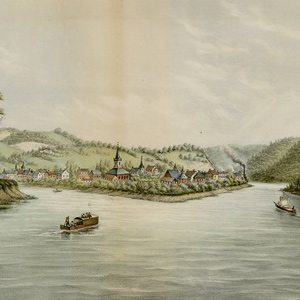
The Corps of Discovery, as it would be called, or the “corps of volunteers for North Western Discovery,” as Lewis put it, epitomized the rising glory of the United States—its sense of limitless possibilities and unparalleled opportunities.
Louisiana’s Political Geography
by Joseph A. Mussulman, Pierce Mullen
On 9 April 1682, René La Salle, claimed “possession of this country of Louisiana.” Thus, without any belligerent confrontations began the decline of one already ancient meta-culture, and the rise of a succession of new empires.
The Barge
Barge, keelboat, or just 'the boat'?
by Joseph A. Mussulman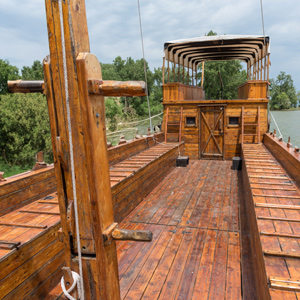
Meriwether Lewis listed a “Keeled Boat” in his pre-expedition shopping list, but after he finally got it, he and the other journalists of the Corps of Discovery simply called it “the boat” (190 times) or, less often, “the barge” (32 times).
The Mouth of the Ohio
Meeting of the waters
by Joseph A. Mussulman
On the evening of 14 November 1803, Lewis and Clark camped on the point between the Ohio and Mississippi Rivers. By now they had rowed, poled, dragged, and occasionally sailed their boats a total of 981 miles.
Tywappity Bottom
Early American settlement
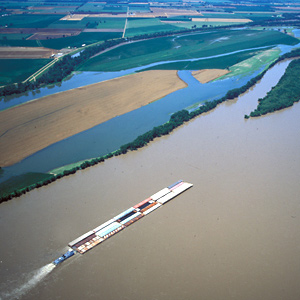
“Arrived oposite three new habitation of some Americans who had settled under the Spanish government,” wrote Lewis on 22 November 1803. “This settlement is on a bottom called, Tywappety.” Major Amos Stoddard described the area in 1812.
The Grand Tower
Demons
by Joseph A. Mussulman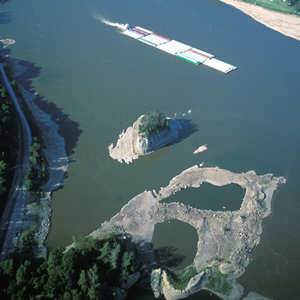
In 1673 French explorers Père Marquette and Louis Joliet listened to local Indians’ warnings about this place and erected a cross atop the ninety-foot-high rock to disempower the demons said to be lurking in the treacherous whirlpool at its base.
Fort Kaskaskia
Preliminary outpost

Archaeological investigations by the author and his students reveal the location of the American Fort Kaskaskia. Extracts from “Bound to the Western Waters: Searching for Lewis and Clark at Fort Kaskaskia, Illinois” by the lead archaeologist.
St. Louis
Gateway to the west
by Frances H. Stadler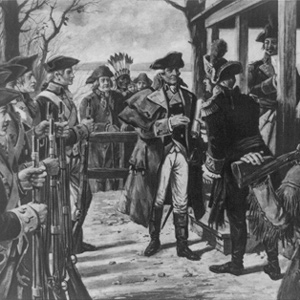
In 1804 and in the presence of the Lewis and Clark expedition the little village, built and designed to be an outpost of the fur trade, shed its ambiguous Spanish-French parentage and took on full American citizenship.
Experience the Lewis and Clark Trail
The Lewis and Clark Trail Experience—our sister site at lewisandclark.travel—connects the world to people and places on the Lewis and Clark Trail.
Discover More
- The Lewis and Clark Expedition: Day by Day by Gary E. Moulton (University of Nebraska Press, 2018). The story in prose, 14 May 1804–23 September 1806.
- The Lewis and Clark Journals: An American Epic of Discovery (abridged) by Gary E. Moulton (University of Nebraska Press, 2003). Selected journal excerpts, 14 May 1804–23 September 1806.
- The Lewis and Clark Journals. by Gary E. Moulton (University of Nebraska Press, 1983–2001). The complete story in 13 volumes.


